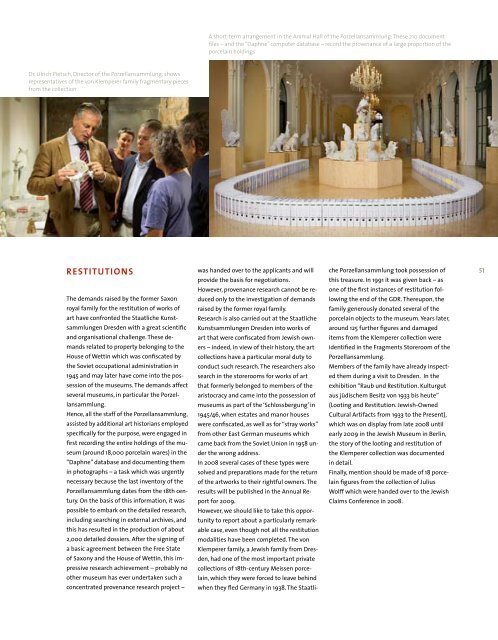2008 - Staatliche Kunstsammlungen Dresden
2008 - Staatliche Kunstsammlungen Dresden
2008 - Staatliche Kunstsammlungen Dresden
You also want an ePaper? Increase the reach of your titles
YUMPU automatically turns print PDFs into web optimized ePapers that Google loves.
Dr. Ulrich Pietsch, Director of the Porzellansammlung, shows<br />
representatives of the von Klemperer family fragmentary pieces<br />
from the collection<br />
REsTiTUTiONs<br />
The demands raised by the former Saxon<br />
royal family for the restitution of works of<br />
art have confronted the <strong>Staatliche</strong> <strong>Kunstsammlungen</strong><br />
<strong>Dresden</strong> with a great scientific<br />
and organisational challenge. These demands<br />
related to property belonging to the<br />
House of Wettin which was confiscated by<br />
the Soviet occupational administration in<br />
1945 and may later have come into the possession<br />
of the museums. The demands affect<br />
several museums, in particular the Porzellansammlung.<br />
Hence, all the staff of the Porzellansammlung,<br />
assisted by additional art historians employed<br />
specifically for the purpose, were engaged in<br />
first recording the entire holdings of the museum<br />
(around 18,000 porcelain wares) in the<br />
“Daphne” database and documenting them<br />
in photographs – a task which was urgently<br />
necessary because the last inventory of the<br />
Porzellansammlung dates from the 18th century.<br />
On the basis of this information, it was<br />
possible to embark on the detailed research,<br />
including searching in external archives, and<br />
this has resulted in the production of about<br />
2,000 detailed dossiers. After the signing of<br />
a basic agreement between the Free State<br />
of Saxony and the House of Wettin, this impressive<br />
research achievement – probably no<br />
other museum has ever undertaken such a<br />
concentrated provenance research project –<br />
A short-term arrangement in the Animal Hall of the Porzellansammlung: These 210 document<br />
files – and the “Daphne” computer database – record the provenance of a large proportion of the<br />
porcelain holdings<br />
was handed over to the applicants and will<br />
provide the basis for negotiations.<br />
However, provenance research cannot be reduced<br />
only to the investigation of demands<br />
raised by the former royal family.<br />
Research is also carried out at the <strong>Staatliche</strong><br />
<strong>Kunstsammlungen</strong> <strong>Dresden</strong> into works of<br />
art that were confiscated from Jewish owners<br />
– indeed, in view of their history, the art<br />
collections have a particular moral duty to<br />
conduct such research. The researchers also<br />
search in the storerooms for works of art<br />
that formerly belonged to members of the<br />
aristocracy and came into the possession of<br />
museums as part of the ‘Schlossbergung’ in<br />
1945/46, when estates and manor houses<br />
were confiscated, as well as for “stray works”<br />
from other East German museums which<br />
came back from the Soviet Union in 1958 under<br />
the wrong address.<br />
In <strong>2008</strong> several cases of these types were<br />
solved and preparations made for the return<br />
of the artworks to their rightful owners. The<br />
results will be published in the Annual Report<br />
for 2009.<br />
However, we should like to take this opportunity<br />
to report about a particularly remarkable<br />
case, even though not all the restitution<br />
modalities have been completed. The von<br />
Klemperer family, a Jewish family from <strong>Dresden</strong>,<br />
had one of the most important private<br />
collections of 18th-century Meissen porcelain,<br />
which they were forced to leave behind<br />
when they fled Germany in 1938. The Staatli-<br />
che Porzellansammlung took possession of<br />
this treasure. In 1991 it was given back – as<br />
one of the first instances of restitution following<br />
the end of the GDR. Thereupon, the<br />
family generously donated several of the<br />
porcelain objects to the museum. Years later,<br />
around 125 further figures and damaged<br />
items from the Klemperer collection were<br />
identified in the Fragments Storeroom of the<br />
Porzellansammlung.<br />
Members of the family have already inspected<br />
them during a visit to <strong>Dresden</strong>. In the<br />
exhibition “Raub und Restitution. Kulturgut<br />
aus jüdischem Besitz von 1933 bis heute”<br />
(Looting and Restitution. Jewish-Owned<br />
Cultural Artifacts from 1933 to the Present),<br />
which was on display from late <strong>2008</strong> until<br />
early 2009 in the Jewish Museum in Berlin,<br />
the story of the looting and restitution of<br />
the Klemperer collection was documented<br />
in detail.<br />
Finally, mention should be made of 18 porcelain<br />
figures from the collection of Julius<br />
Wolff which were handed over to the Jewish<br />
Claims Conference in <strong>2008</strong>.<br />
51

















